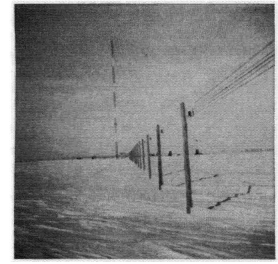|
Static Draining of Antenna Feeder Systems
Author: Edmund A. Laport
Induction from lightning and the accumulation of charges from windblown sand, dust, and dry snow cause very high static potentials to
accumulate on an aerial system. These potentials can rise to a value that may cause eventual flashover, with a following power arc in the case of transmitting. In receiving, the system can become excessively noisy owing to precipitation static. It is therefore necessary to provide for static drains in designing a system. A low-resistance, and preferably low-reactance, path from antenna to earth will serve as a drain circuit, but it must be arranged to have a minimum influence on the impedances at the working frequency. Drain choke coils are frequently used in low-and medium-frequency systems for this purpose and occasionally in high-frequency systems. In high-frequency balanced systems, a branch section of line bridging the main feeder, short-circuited one-quarter wavelength from the connection and grounded at or beyond the short circuit, has very desirable draining characteristics. When a dissipation line is used with a rhombic antenna, the end of the dissipation line can be short-circuited and grounded for draining purposes.
 |
| FIG. 4.71. A straight run of six-wire unbalanced (type XI) transmission line using the side-mounting bracket assembly on round wood poles. One radiator of a directive array with its coupling house, is in the distance. (Photograph courtesy of RCA Victor Company, Ltd., Montreal.)
|
|


 Radio-frequency Transmission Lines
Radio-frequency Transmission Lines  Static Draining of Antenna Feeder Systems
Static Draining of Antenna Feeder Systems





 Radio-frequency Transmission Lines
Radio-frequency Transmission Lines  Static Draining of Antenna Feeder Systems
Static Draining of Antenna Feeder Systems

